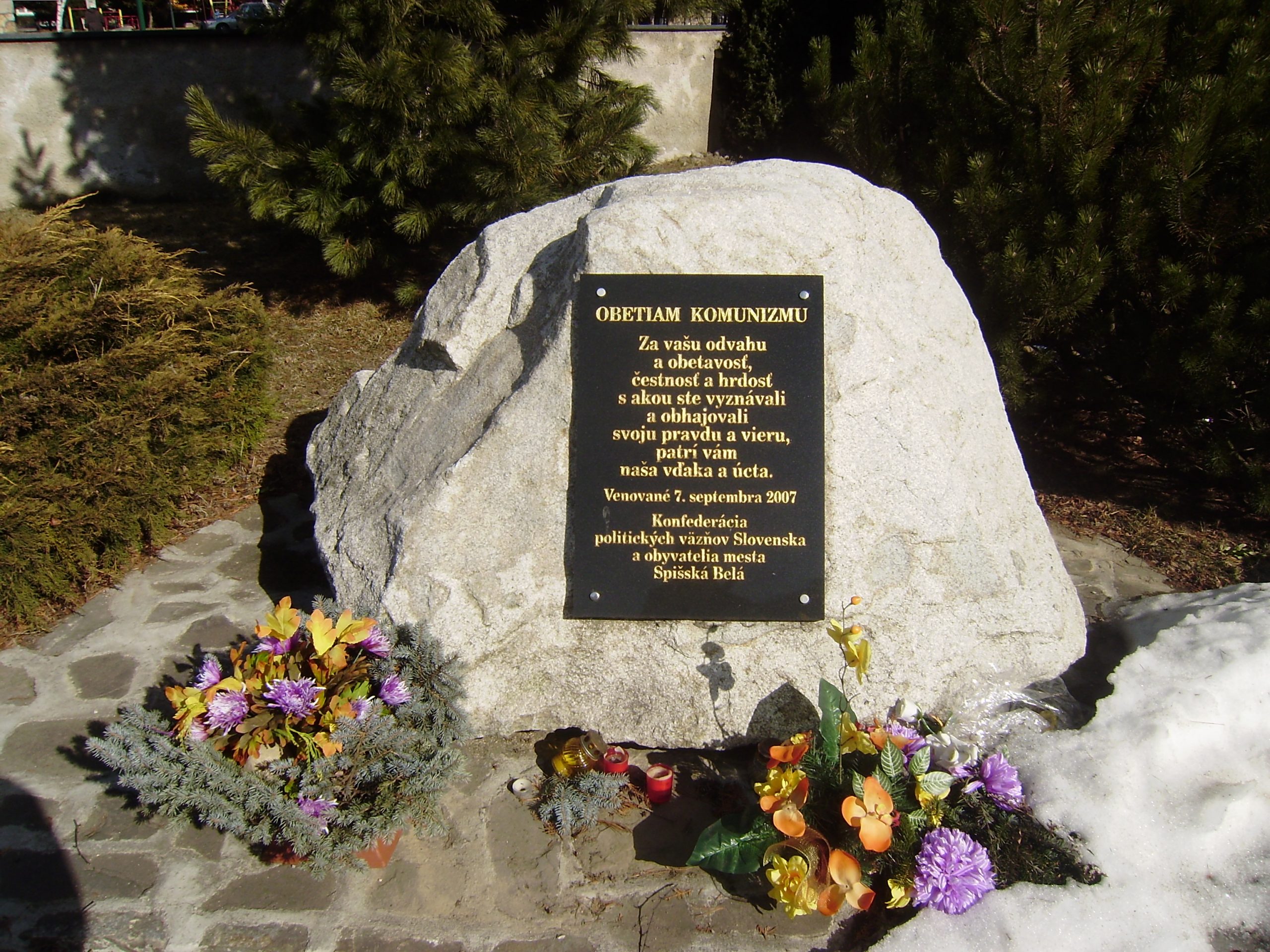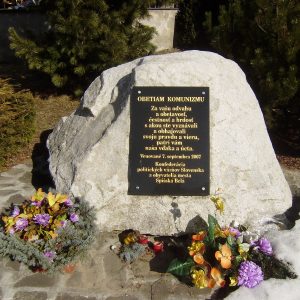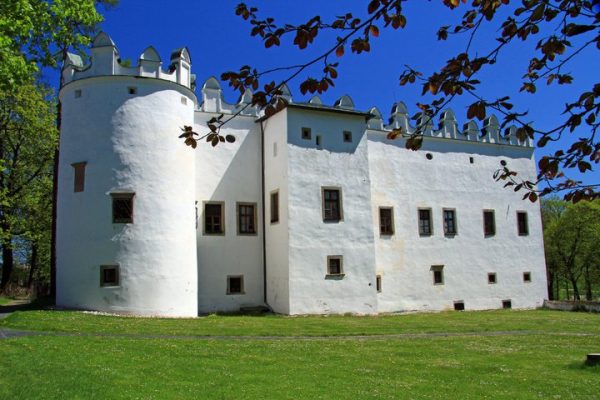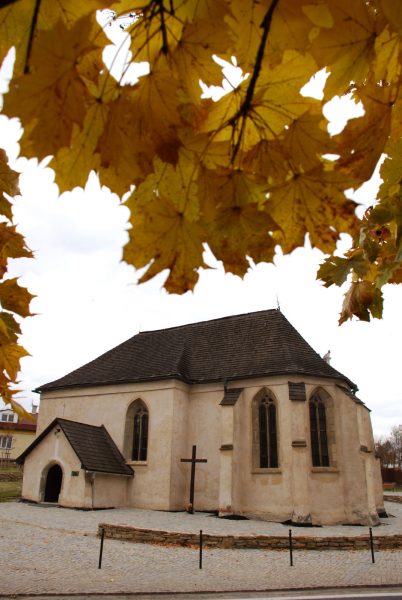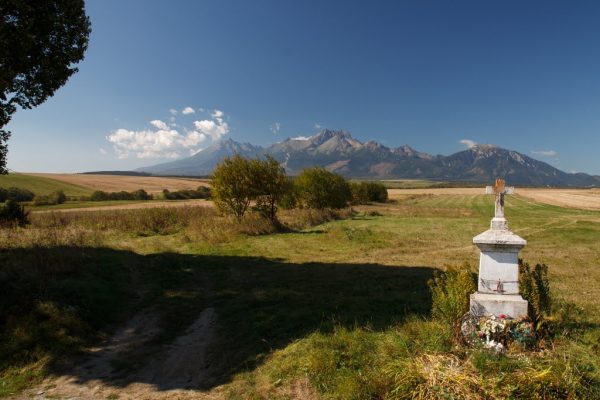15. Pamätník obetiam komunizmu
![]() Na cintoríne pri vstupe ku domu smútku sa po ľavej strane nachádza pamätník obetiam komunizmu. Kus kameňa, ktorý pre nezainteresovaných neznamená nič. Pre tých, ktorých sa komunistické prenasledovanie dotklo, znamená často zničené životy a zdravie nielen väznených, ale často aj ich rodín. Najprv to bolo 34 mužov odvlečených hneď vo februári 1945 do táborov nútených prác v Rusku. Tak ako silnel komunistický teror, tak sa pomaly začal formovať aj jeho odboj. Jedným z prvých jeho prejavov bolo vysielanie vysielačky Biela légia, ktoré sa začalo v máji 1950. Aj mladí ľudia prevažne zo Spolku katolíckej mládeže v Spišskej Belej so záujmom počúvali zakázané vysielanie. Komunisti štátnou Katolíckou akciou chceli konšpiratívne narušiť cirkevnú hierarchiu. Náboženský život v meste im bol tŕňom v oku, a preto svoj útok zamerali na kňazov a mládež z okruhu spolku. Kňazi Štefan Vaverčák a Ján Lang boli odvlečení do väzenia priamo z fary a kaplán Štefan Baláž ich nasledoval onedlho. Pre ilustráciu uvedieme len počet kňazov, ktorí pôsobili, alebo sa narodili v Spišskej Belej a boli nespravodlivo odsúdení a väznení komunistickým režimom. Trinásť kňazov spolu strávilo 63 rokov vo väzniciach a uránových baniach. Násilné odoberanie pôdy a zakladanie družstiev vyvolalo medzi roľníkmi odpor a obavy, pretože mnohí si priniesli spomienky z ruského frontu v podobe hladomormi nivočeného Ruska, ktoré im domáci komunisti dávali za vzor kolektivizácie. Tiež prví väzni vracajúci sa z ruských gulagov prinášali správy o biede, terore a hlade v Rusku. V atmosfére týchto udalostí a pod vplyvom vysielania rádia Biela légia študenti gymnázia v Kežmarku Bohuš Jakubjak zo Spišskej Belej a Peter Drozd z Kežmarku sformulovali výzvu k občanom, aby bránili kňazov, náboženstvo , aby nevstupovali do družstiev a nepoddávali sa komunistickej moci. Ich bývalý spolužiak František Olšák napísal text na rozmnožovaciu blanu, ktorú zobral na MsNV v Poprade, kde už pracoval. V dome Lenky Rennerovej v Spišskej Belej, ktorá zabezpečila tlačiareň, bol text vytlačený. Výsledkom bol bitie, vypočúvanie a súd, pred ktorým stálo 17 mladých ľudí, z toho dve dievčatá. Ich priemerný vek bol 22 rokov. Sudkyňa v Bratislave ich odsúdila spolu na 122 rokov a mesiac žalára. Z toho skutočne odsedeli 72 rokov a 5 mesiacov.
Na cintoríne pri vstupe ku domu smútku sa po ľavej strane nachádza pamätník obetiam komunizmu. Kus kameňa, ktorý pre nezainteresovaných neznamená nič. Pre tých, ktorých sa komunistické prenasledovanie dotklo, znamená často zničené životy a zdravie nielen väznených, ale často aj ich rodín. Najprv to bolo 34 mužov odvlečených hneď vo februári 1945 do táborov nútených prác v Rusku. Tak ako silnel komunistický teror, tak sa pomaly začal formovať aj jeho odboj. Jedným z prvých jeho prejavov bolo vysielanie vysielačky Biela légia, ktoré sa začalo v máji 1950. Aj mladí ľudia prevažne zo Spolku katolíckej mládeže v Spišskej Belej so záujmom počúvali zakázané vysielanie. Komunisti štátnou Katolíckou akciou chceli konšpiratívne narušiť cirkevnú hierarchiu. Náboženský život v meste im bol tŕňom v oku, a preto svoj útok zamerali na kňazov a mládež z okruhu spolku. Kňazi Štefan Vaverčák a Ján Lang boli odvlečení do väzenia priamo z fary a kaplán Štefan Baláž ich nasledoval onedlho. Pre ilustráciu uvedieme len počet kňazov, ktorí pôsobili, alebo sa narodili v Spišskej Belej a boli nespravodlivo odsúdení a väznení komunistickým režimom. Trinásť kňazov spolu strávilo 63 rokov vo väzniciach a uránových baniach. Násilné odoberanie pôdy a zakladanie družstiev vyvolalo medzi roľníkmi odpor a obavy, pretože mnohí si priniesli spomienky z ruského frontu v podobe hladomormi nivočeného Ruska, ktoré im domáci komunisti dávali za vzor kolektivizácie. Tiež prví väzni vracajúci sa z ruských gulagov prinášali správy o biede, terore a hlade v Rusku. V atmosfére týchto udalostí a pod vplyvom vysielania rádia Biela légia študenti gymnázia v Kežmarku Bohuš Jakubjak zo Spišskej Belej a Peter Drozd z Kežmarku sformulovali výzvu k občanom, aby bránili kňazov, náboženstvo , aby nevstupovali do družstiev a nepoddávali sa komunistickej moci. Ich bývalý spolužiak František Olšák napísal text na rozmnožovaciu blanu, ktorú zobral na MsNV v Poprade, kde už pracoval. V dome Lenky Rennerovej v Spišskej Belej, ktorá zabezpečila tlačiareň, bol text vytlačený. Výsledkom bol bitie, vypočúvanie a súd, pred ktorým stálo 17 mladých ľudí, z toho dve dievčatá. Ich priemerný vek bol 22 rokov. Sudkyňa v Bratislave ich odsúdila spolu na 122 rokov a mesiac žalára. Z toho skutočne odsedeli 72 rokov a 5 mesiacov.
V Spišskej Belej sa narodil aj jeden z posledných väzňov komunizmu, kňaz František Novajovský, ktorý bol v roku 1986 odsúdený a uväznený.
15. Monument for the Victims of Communism
![]() The Monument for the Victims of Communism is located in the cemetery, on the left side of the entrance to the House of Grief. For those who are not interested, this piece of stone has no meaning. But those who were affected by communist persecution saw the health and lives of their friends and often their relatives destroyed. As early as February 1945, 34 men were deported to forced labor camps in Russia. The great terror of communism lead to the slow formation of a resistance movement. One of the first resistance manifestos was disseminated by the Biela légia, which was founded in May 1950. Young people, most often from the society of the Catholic youth in Spišská Belá, followed the banned broadcasts with great interest. The Communists wanted to penetrate the Catholic hierarchy through a series of measures they named “Catholic Action”. The religious life in the city was a thorn in their side and so they attacked both clergymen and young members of the religious community. The clergymen Štefan Vaverčák and Ján Lang were brought to prison directly from the vicarage and Chaplain Štefan Baláž was arrested not much later. We have limited our focus and are mentioning only those clergymen who worked or were born in Spišská Belá and were convicted and imprisoned unrightfully by the communist regime. Thirteen clergymen spent a total of 63 years behind prison walls and in uranium mines. The forced nationalization of land and the establishing of collective farms filled the farmers with fear, because many had memories of the front in Russia, where a famine had ravaged the country, and after the example of which the domestic collectivization of land was modeled. In addition, the first prisoners who returned from the Russian gulags brought reports of misery, terror and hunger. Against the background of these events, and influenced by the Biela légia broadcasts, a student of the Kežmarok secondary school, Bohuš Jakubjak, and a student from Spišská Belá, Bohuš Jakubjak, as well as Peter Drozd, also of Keyžmarok, wrote an appeal to citizens to defend the clergymen as well as the clergy, imploring them not to join the collective farms and not to submit to the communist power. Their former classmate, František Olšák, wrote the text of this appeal on a banner, which he stole from the Communist Town Hall in Poprad, where he had started working. The text was printed in the house of Lenka Rennerova in Spišská Belá. What followed were beatings and the interrogation and trial of 17 young people, two of them girls. Their average age was 22. A Bratislava judge sentenced them to a total of 122 years and one month in prison. They spent a total of 72 years and 5 months of this sentence behind bars. One of the last communist prisoners was born in Spišská Belá, clergyman František Novajovský, who was convicted and imprisoned in 1986.
The Monument for the Victims of Communism is located in the cemetery, on the left side of the entrance to the House of Grief. For those who are not interested, this piece of stone has no meaning. But those who were affected by communist persecution saw the health and lives of their friends and often their relatives destroyed. As early as February 1945, 34 men were deported to forced labor camps in Russia. The great terror of communism lead to the slow formation of a resistance movement. One of the first resistance manifestos was disseminated by the Biela légia, which was founded in May 1950. Young people, most often from the society of the Catholic youth in Spišská Belá, followed the banned broadcasts with great interest. The Communists wanted to penetrate the Catholic hierarchy through a series of measures they named “Catholic Action”. The religious life in the city was a thorn in their side and so they attacked both clergymen and young members of the religious community. The clergymen Štefan Vaverčák and Ján Lang were brought to prison directly from the vicarage and Chaplain Štefan Baláž was arrested not much later. We have limited our focus and are mentioning only those clergymen who worked or were born in Spišská Belá and were convicted and imprisoned unrightfully by the communist regime. Thirteen clergymen spent a total of 63 years behind prison walls and in uranium mines. The forced nationalization of land and the establishing of collective farms filled the farmers with fear, because many had memories of the front in Russia, where a famine had ravaged the country, and after the example of which the domestic collectivization of land was modeled. In addition, the first prisoners who returned from the Russian gulags brought reports of misery, terror and hunger. Against the background of these events, and influenced by the Biela légia broadcasts, a student of the Kežmarok secondary school, Bohuš Jakubjak, and a student from Spišská Belá, Bohuš Jakubjak, as well as Peter Drozd, also of Keyžmarok, wrote an appeal to citizens to defend the clergymen as well as the clergy, imploring them not to join the collective farms and not to submit to the communist power. Their former classmate, František Olšák, wrote the text of this appeal on a banner, which he stole from the Communist Town Hall in Poprad, where he had started working. The text was printed in the house of Lenka Rennerova in Spišská Belá. What followed were beatings and the interrogation and trial of 17 young people, two of them girls. Their average age was 22. A Bratislava judge sentenced them to a total of 122 years and one month in prison. They spent a total of 72 years and 5 months of this sentence behind bars. One of the last communist prisoners was born in Spišská Belá, clergyman František Novajovský, who was convicted and imprisoned in 1986.
15. Denkmal für die Opfer des Kommunismus
![]() Wenn man den Friedhof beim Leichenhaus betritt, dann stößt man links auf das Denkmal für die Opfer des Kommunismus – auf einen Stein, der für Uninteressierte nichts bedeutet. Für die von kommunistischer Verfolgung Betroffenen aber bedeutet er zerstörtes Leben und ruinierte Gesundheit nicht nur der damals Inhaftierten, sondern sehr oft auch ihrer Familien. Zunächst waren es 34 Männer, die gleich im Februar 1945 in Zwangsarbeitslager nach Russland verschleppt wurden. So wie der kommunistische Terror zunahm, so begann sich allmählich auch Widerstand dagegen zu formieren. Eine der erste Äußerungen dieses Widerstands waren Sendungen des Senders Biela legia, „Weiße Legion“, die im Mai 1950 begannen. Auch junge Menschen überwiegend vom Bund der katholischen Jugend in Zipser Bela verfolgten die verbotenen Sendungen mit Interesse. Mit der staatlich gelenkten Katholischen Aktion wollten die Kommunisten die Kirchenhierarchie konspirativ unterwandern. Das religiöse Leben in der Stadt war ihnen ein Dorn im Auge, weshalb sie ihren Angriff gegen Priester und Jugendliche aus dem Kreis des katholischen Jugendbundes richteten. Die Priester Štefan Vaverčák und Ján Lang wurden direkt aus dem Pfarramt ins Gefängnis verschleppt. Kaplan Štefan Baláž folgte ihnen kurze Zeit später. Zur Illustrierung sei nur die Zahl jener Priester angeführt, die in Zipser Bela tätig waren oder hier geboren wurden und vom kommunistischen Regime unrechtmäßig verurteilt und inhaftiert wurden. Dreizehn Priester brachten insgesamt 63 Jahre in Gefängnissen und Uranbergwerken zu. Gewaltsame Beschlagnahme des Bodens und die Gründung von Genossenschaften rief unter den Bauern Widerstand und Befürchtungen hervor. In vielen von ihnen war nämlich die Erinnerung an die russische Front und das durch Hungersnöte verödete Russland, das ihnen die einheimischen Kommunisten als Vorbild für die Kollektivierung priesen, noch lebhaft in Erinnerung. Und auch die ersten Heimkehrer aus den russischen Gulag-Straflagern brachten Nachrichten über das Elend, den Terror und den Hunger in Russland mit. In dieser Atmosphäre und unter dem Einfluss der Sendungen von Radio Biela legia formulierten Bohuš Jakubjak aus Zipser Bela /Spišská Belá und Peter Drozd aus Käsmark, Schüler des Gymnasiums in Käsmark, ihren Aufruf an die Bürger, Priester und Religion zu verteidigen, den Genossenschaften nicht beizutreten und sich der kommunistischen Macht nicht zu beugen. Ihr ehemaliger Mitschüler František Olšák schrieb den Text auf eine Kopierfolie, die er sich aus dem Stadtamt in Poprad besorgt hatte, wo er bereits arbeitete. Im Hause von Lenka Rennerova in Zipser Bela / Spišská Belá, die für die Druckerei zu sorgen hatte, wurde der Text gedruckt. Das Ergebnis waren Schläge, Verhör und Gericht, vor welchem siebzehn junge Menschen standen, davon zwei Mädchen. Ihr Durchschnittsalter betrug 22 Jahre. Die Richterin in Bratislava verurteilte sie zu insgesamt 122 Jahren und einen Monat Haft. Davon saßen sie 72 Jahre und 5 Monate ab. In Zipser Bela wurde auch einer der letzten Häftlinge des kommunistischen Regimes geboren, der Priester František Novajovský, der 1986 verurteilt und inhaftiert wurde.
Wenn man den Friedhof beim Leichenhaus betritt, dann stößt man links auf das Denkmal für die Opfer des Kommunismus – auf einen Stein, der für Uninteressierte nichts bedeutet. Für die von kommunistischer Verfolgung Betroffenen aber bedeutet er zerstörtes Leben und ruinierte Gesundheit nicht nur der damals Inhaftierten, sondern sehr oft auch ihrer Familien. Zunächst waren es 34 Männer, die gleich im Februar 1945 in Zwangsarbeitslager nach Russland verschleppt wurden. So wie der kommunistische Terror zunahm, so begann sich allmählich auch Widerstand dagegen zu formieren. Eine der erste Äußerungen dieses Widerstands waren Sendungen des Senders Biela legia, „Weiße Legion“, die im Mai 1950 begannen. Auch junge Menschen überwiegend vom Bund der katholischen Jugend in Zipser Bela verfolgten die verbotenen Sendungen mit Interesse. Mit der staatlich gelenkten Katholischen Aktion wollten die Kommunisten die Kirchenhierarchie konspirativ unterwandern. Das religiöse Leben in der Stadt war ihnen ein Dorn im Auge, weshalb sie ihren Angriff gegen Priester und Jugendliche aus dem Kreis des katholischen Jugendbundes richteten. Die Priester Štefan Vaverčák und Ján Lang wurden direkt aus dem Pfarramt ins Gefängnis verschleppt. Kaplan Štefan Baláž folgte ihnen kurze Zeit später. Zur Illustrierung sei nur die Zahl jener Priester angeführt, die in Zipser Bela tätig waren oder hier geboren wurden und vom kommunistischen Regime unrechtmäßig verurteilt und inhaftiert wurden. Dreizehn Priester brachten insgesamt 63 Jahre in Gefängnissen und Uranbergwerken zu. Gewaltsame Beschlagnahme des Bodens und die Gründung von Genossenschaften rief unter den Bauern Widerstand und Befürchtungen hervor. In vielen von ihnen war nämlich die Erinnerung an die russische Front und das durch Hungersnöte verödete Russland, das ihnen die einheimischen Kommunisten als Vorbild für die Kollektivierung priesen, noch lebhaft in Erinnerung. Und auch die ersten Heimkehrer aus den russischen Gulag-Straflagern brachten Nachrichten über das Elend, den Terror und den Hunger in Russland mit. In dieser Atmosphäre und unter dem Einfluss der Sendungen von Radio Biela legia formulierten Bohuš Jakubjak aus Zipser Bela /Spišská Belá und Peter Drozd aus Käsmark, Schüler des Gymnasiums in Käsmark, ihren Aufruf an die Bürger, Priester und Religion zu verteidigen, den Genossenschaften nicht beizutreten und sich der kommunistischen Macht nicht zu beugen. Ihr ehemaliger Mitschüler František Olšák schrieb den Text auf eine Kopierfolie, die er sich aus dem Stadtamt in Poprad besorgt hatte, wo er bereits arbeitete. Im Hause von Lenka Rennerova in Zipser Bela / Spišská Belá, die für die Druckerei zu sorgen hatte, wurde der Text gedruckt. Das Ergebnis waren Schläge, Verhör und Gericht, vor welchem siebzehn junge Menschen standen, davon zwei Mädchen. Ihr Durchschnittsalter betrug 22 Jahre. Die Richterin in Bratislava verurteilte sie zu insgesamt 122 Jahren und einen Monat Haft. Davon saßen sie 72 Jahre und 5 Monate ab. In Zipser Bela wurde auch einer der letzten Häftlinge des kommunistischen Regimes geboren, der Priester František Novajovský, der 1986 verurteilt und inhaftiert wurde.
15. Pomnik ofiar komunizmu
![]() Na cmentarzu po lewej stronie od wejściu do Domu żałobnego znajduje się pomnik ofiar komunizmu. Zwykły kamień, który niezainteresowanym nic nie mówi. Dla tych, których dotknęły prześladowania komunistyczne, oznacza zmarnowane życia i zdrowie nie tylko uwięzionych, ale także nie rzadko ich rodzin. Już w lutym 1945 roku wywieziono do obozów pracy przymusowej w Związku Radzieckim 34 mężczyzn. Nasilający się terror komunistyczny powodował, że zaczął formować się opór przeciwko niemu. Jednym z pierwszych jego przejawów były audycje nadawane od maja 1950 roku przez radio Biała Legia. Młodzi ludzie, głównie ze Stowarzyszenia Młodzieży Katolickiej w Białej Spiskiej, z wielką uwagą słuchali tych zakazanych transmisji. Komuniści poprzez państwową Akcję Katolicką w zakonspirowany sposób chcieli uderzyć w chierarchię kościelną. Życie religijne w mieście było im cierniem w oku i dlatego swój atak skierowali przede wszystkim przeciwko duchownym i młodzieży ze stowarzyszenia. Księża Štefan Vaverčák i Ján Lang byli wywiezieni prosto z kościoła, a wkrótce podobny los spotkał także księdza Štefana Baláža. Dla orientacji podamy ilość duchownych, działających lub urodzonych w Białej Spiskiej, którzy zostali niesprawiedliwie osądzeni i uwięzieni przez reżim komunistyczny. Trzynastu księży spędziło razem 63 lata w więzieniach i kopalniach uranu. Przemocą odbierana ziemia i zakładanie spółdzielni rolniczych wywołało wśród rolników opór i strach. Wielu z nich pamiętało jeszcze z frontu sowieckiego głód nękający Związek Radziecki, stawiany im przez komunistów za wzór w czasie kolektywizacji. Również pierwsi więźniowie powracający z radzieckich gułagów przynosili wieści o biedzie, terrorze i głodzie. W tej atmosferze i pod wpływem radia Biała Legia uczniowie gimnazjum w Kieżmarku Bohuš Jakubjak z Białej Spiskiej i Peter Drozd z Kieżmarku sformuowali odezwę, w której nawoływali do obrony duchownych i wiary, odmowy wstępowania do spółdzielni rolniczych i nieulegania komunistom.
Na cmentarzu po lewej stronie od wejściu do Domu żałobnego znajduje się pomnik ofiar komunizmu. Zwykły kamień, który niezainteresowanym nic nie mówi. Dla tych, których dotknęły prześladowania komunistyczne, oznacza zmarnowane życia i zdrowie nie tylko uwięzionych, ale także nie rzadko ich rodzin. Już w lutym 1945 roku wywieziono do obozów pracy przymusowej w Związku Radzieckim 34 mężczyzn. Nasilający się terror komunistyczny powodował, że zaczął formować się opór przeciwko niemu. Jednym z pierwszych jego przejawów były audycje nadawane od maja 1950 roku przez radio Biała Legia. Młodzi ludzie, głównie ze Stowarzyszenia Młodzieży Katolickiej w Białej Spiskiej, z wielką uwagą słuchali tych zakazanych transmisji. Komuniści poprzez państwową Akcję Katolicką w zakonspirowany sposób chcieli uderzyć w chierarchię kościelną. Życie religijne w mieście było im cierniem w oku i dlatego swój atak skierowali przede wszystkim przeciwko duchownym i młodzieży ze stowarzyszenia. Księża Štefan Vaverčák i Ján Lang byli wywiezieni prosto z kościoła, a wkrótce podobny los spotkał także księdza Štefana Baláža. Dla orientacji podamy ilość duchownych, działających lub urodzonych w Białej Spiskiej, którzy zostali niesprawiedliwie osądzeni i uwięzieni przez reżim komunistyczny. Trzynastu księży spędziło razem 63 lata w więzieniach i kopalniach uranu. Przemocą odbierana ziemia i zakładanie spółdzielni rolniczych wywołało wśród rolników opór i strach. Wielu z nich pamiętało jeszcze z frontu sowieckiego głód nękający Związek Radziecki, stawiany im przez komunistów za wzór w czasie kolektywizacji. Również pierwsi więźniowie powracający z radzieckich gułagów przynosili wieści o biedzie, terrorze i głodzie. W tej atmosferze i pod wpływem radia Biała Legia uczniowie gimnazjum w Kieżmarku Bohuš Jakubjak z Białej Spiskiej i Peter Drozd z Kieżmarku sformuowali odezwę, w której nawoływali do obrony duchownych i wiary, odmowy wstępowania do spółdzielni rolniczych i nieulegania komunistom.
Ich były kolega szkolny František Olšák przygotował tekst do powielenia i zabrał go do urzędu miejskiego w Popradzie, gdzie pracował. W domu Lenky Rennerovej w Białej Spiskiej odezwa została wydrukowana. Akcja zakończyła się biciem, przesłuchaniami i sądem, przed którym stanęło 17 młodych ludzi, w tym dwie kobiety. Wszyscy razem średnio mieli 22 lata. Sędzina w Bratysławie skazała ich na łącznie 122 lata i miesiąc więzienia. Z tego odsiedzieli 72 lata i 5 miesięcy.
W Białej Spiskiej urodził się także jeden z ostatnich więźniów komunizmu, ksiądz František Novajovský, skazany i uwięziony w 1986 roku.

